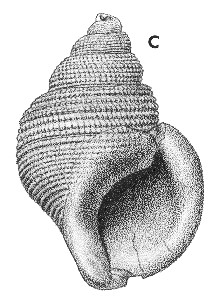
Revised descriptions of New Zealand Cenozoic Mollusca from Beu and Maxwell (1990)

 | Revised descriptions of New Zealand Cenozoic Mollusca from Beu and Maxwell (1990) | 
|
  (Pl. 42c): GS2855, U24/f6440, Waitahora Road, Mangaotoro, southern Hawke's Bay, early Nukumaruan (GNS) |
Beu & Maxwell (1990): Chapter 15; p. 321; pl. 42 c.
Synonymy: Struthiolaria rugosa Marwick 1924b, p. 189
Classification: Struthiolariidae
Description: Moderate-sized for genus (45-48 mm high), with moderately tall spire (a little shorter than aperture), narrow horizontal sutural ramp, evenly and weakly convex whorls, and normal Pelicaria aperture with weakly sinuous, varicate outer lip meeting thick, narrow, smooth inner lip at very shallow anterior notch. Sculpture of low, narrow, well defined, closely spaced spiral cords, about 10 on spire whorls and 25 on last whorl, crossed and made finely and regularly nodulous by many low, narrow axial costellae about the same distance apart as spiral cords. Protoconch typical (see P. vermis form convexa).
Comparison: A possibly ancestral species, Pelicaria monilifera, rare in the Opoitian-Waipipian of Marlborough and North Canterbury, has a taller spire, wider spiral cords and coarser nodules than P. rugosa. Pelicaria rugosa is similar in shape to the convexa form of P. vermis, but differs in its distinctive sculpture of many narrow spiral cords crossed by axial costellae, forming many small nodules at the sculptural intersections.
Distribution: Early Nukumaruan only; "Patea", South Taranaki coast (wrong; Patea is a Waipipian locality, where P. rugosa has not been recollected), type. Widespread in southern Hawke's Bay to North Canterbury in a very short-lived zone near the base of early Nukumaruan time, almost always with Zygochlamys delicatula; common in a thin zone in Mangaopari Stream at Birch Hill bridge, near the junction with Makara River; at the mouth of Whangaimoana Stream, Palliser Bay (both in southern Wairarapa); and at Motunau Beach and in Zygochlamys delicatula beds on Gower River (both in North Canterbury). The holotype (TM4898, GNS) is an unusually coarsely sculptured specimen, with matrix of grey sandy mudstone (hard in the aperture but soft around the spire suture) and appears to have come from North Canterbury (perhaps from Motunau Beach) rather than from a North Island locality.
Cite this publication as: "A.G. Beu and J.I. Raine (2009). Revised
descriptions of New Zealand Cenozoic Mollusca from Beu and Maxwell (1990). GNS
Science miscellaneous series no. 27."
© GNS Science, 2009
ISBN
978-0-478-19705-1
ISSN 1177-2441
(Included with a PDF facsimile file
copy of New Zealand Geological Survey Paleontological Bulletin 58 in CD version
from: Publications Officer, GNS Science, P.O. Box 30368 Lower Hutt, New
Zealand)